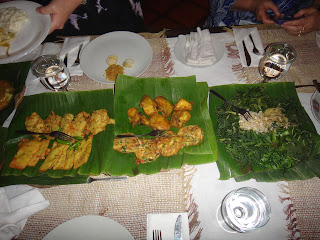After
a really good sleep on Sunday night we woke up early ready for our first full
day in Indonesia. Miss Cooper was woken up at 4:30am by the call to morning prayer. She said that her father would be very impressed that anything had woken her that early in the morning. Breakfast and then out onto the bus ready for our first school visit.
The hotel in which we are staying is right in the centre of Jakarta, which is broken up into north, south, east, west and central Jakarta. One of the problems that Jakarta has is it's traffic. There are so many cars, taksi (taxis) and motorbikes or scooters and they drive everywhere. Our bus had the driver and his co-pilot and I was able to watch the two of them when we were driving. The bus driver really did need his co-pilot - his job was to stick his arm out the window and let the other drivers know that we were changing lanes or moving across the road. It was amazing to watch. The drive, although only about 20 kilometre took over an hour in traffic.
When we arrived we were about 15 minutes late and I immediately felt sorry for the children. In Indonesia the children start school at 6:30am every day and on Monday mornings they have their flag raising ceremony, but Negeri 3 school were going to have their flag raising ceremony for us. By the time we arrived it was probably about 25 degrees and the children were standing in the sun and had been for 15 minutes already.
The students all had their Monday full school uniforms on. They have 5 different uniforms - one for each day of the week. Negeri 3 is a muslim high school. We arrived to the students all standing in lines, boys one end and girls the other
Everyone was very excited to have us visit their school and they were very proud to show us their school and their flag raising ceremony. Apart from the children lined up there was a choir standing to one side and the flag raising children who were all dressed in bright red and yellow uniforms. The children ran the ceremony, which was very impressive and although spoken in Indonesian they also translated most into English for us.
The Principal was then introduced and the children paid their respects to her by saluting her. The flag raising children then marched out with the flag folded up on a tray to the flag pole, where they raised the Indonesian flag. As they did this the choir sang both the Indonesian National Anthem and the Australian National Anthem (both verses!!!).
The children then all recited the Pancasila or their beliefs, the student committment and the opening of the Indonesian Constitution was read. The Principal then spoke about our visit and a little bit about Australia. By this stage it was very warm and the children in their uniforms were very hot. When the ceremony finished with the choir singing another two songs for us. They were an outstanding choir.
Eric the Echidna was there all the way through the flag raising ceremony and indeed as we were making our way into the hall there were many curious Indonesian children who wanted to say hello to him
We then went back inside to the hall where we were meeting. There were many teachers, parents and also people from the local education authority who were also there.
When we were settled we then had another performance from so students who performed about four dances for us. They were absolutely amazing.
We then went and visited some classrooms to talk with the children. The classes that we visited all learn english. They attend school from 6:30am to 5:00pm in the afternoon. We all agreed that was a long day for them. From 3:00pm onwards in the afternoon they have all sorts of different things, however before that it's biology, maths and all the other things that they study. The children spoke very good english and wanted to ask us many questions like what we thought of Indonesian and their school, about learning in Australia, homework and food in Australia
We were served a wonderful Indonesian lunch of rice, satays, rice wrapped in banana leaf and Indonesian sweets; custards, sweet potatoe dumplings and tropical fruits. The food was beautiful and we all felt very full after lunch.
Eric the Echidna enjoyed our lunch too and was a bit of a hit with the teachers and also the Principal who wanted to know all about Echidnas. They were surprised to hear that we actually had had an Echidna at our school and wanted to know if they were vicious.
After we had eaten and the Indonesian teachers and parents had had time to talk with us and ask us questions it was time to leave and head off to our next visit, but not before there was a gift presentation and a photograph. Each school was presented with a beautiful plaque from the school to take back to our school to display. There was then a whole group photo and it was onto the bus and off to Taman Mini Indonesia Indah.























































